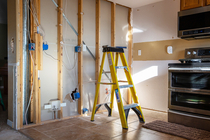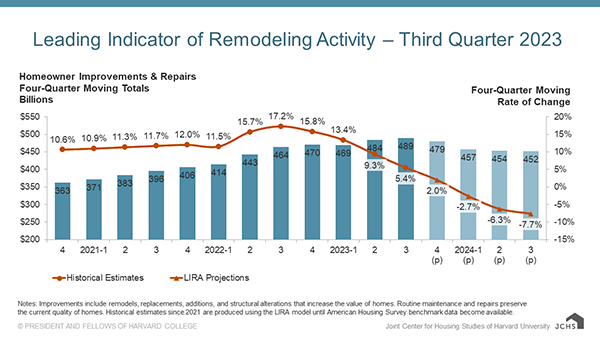Weakening of Residential Remodeling Activity Anticipated for 2024

CAMBRIDGE - Annual spending for improvements and repairs to owner-occupied homes is expected to decrease at a moderate rate over the coming year, according to the Leading Indicator of Remodeling Activity (LIRA) released today by the Remodeling Futures Program at the Joint Center for Housing Studies of Harvard University. The LIRA projects annual owner expenditures for home updates and maintenance to decline by 7.7 percent through the third quarter of 2024.
“The ongoing weakness in the housing market caused by high interest rates and low supply of existing homes is expected to weigh on remodeling activity next year,” says Carlos Martín, Project Director of the Remodeling Futures Program at the Center. “Homeowner concerns about the health and direction of the broader economy may also dampen plans for remodeling projects.”
“The level of annual spending on improvements and repairs is projected to fall from $489 billion today to $452 billion over the coming four quarters,” says Abbe Will, Associate Project Director of the Remodeling Futures Program. “While the rate of market decline should decelerate significantly in the second part of the year, 2024 is shaping up to be a challenging year for home remodeling.”
Click image for full-size chart.
The Leading Indicator of Remodeling Activity (LIRA) provides a short-term outlook of national home improvement and repair spending to owner-occupied homes. The indicator, measured as an annual rate-of-change of its components, is designed to project the annual rate of change in spending for the current quarter and subsequent four quarters, and is intended to help identify future turning points in the business cycle of the home improvement and repair industry. Originally developed in 2007, the LIRA was re-benchmarked in April 2016 to a broader market measure based on the biennial American Housing Survey.
The LIRA is released by the Remodeling Futures Program at the Joint Center for Housing Studies of Harvard University in the third week after each quarter’s closing. The next LIRA release date is January 18, 2024.
The Remodeling Futures Program, initiated by the Joint Center for Housing Studies in 1995, is a comprehensive study of the factors influencing the growth and changing characteristics of housing renovation and repair activity in the United States. The Program seeks to produce a better understanding of the home improvement industry and its relationship to the broader residential construction industry.
The Harvard Joint Center for Housing Studies strives to improve equitable access to decent, affordable homes in thriving communities. We conduct rigorous research to advance policy and practice, and we bring together diverse stakeholders to spark new ideas for addressing housing challenges. Through teaching and fellowships, we mentor and inspire the next generation of housing leaders.
Contact: Kerry Donahue, 617-495-7640, [email protected].

